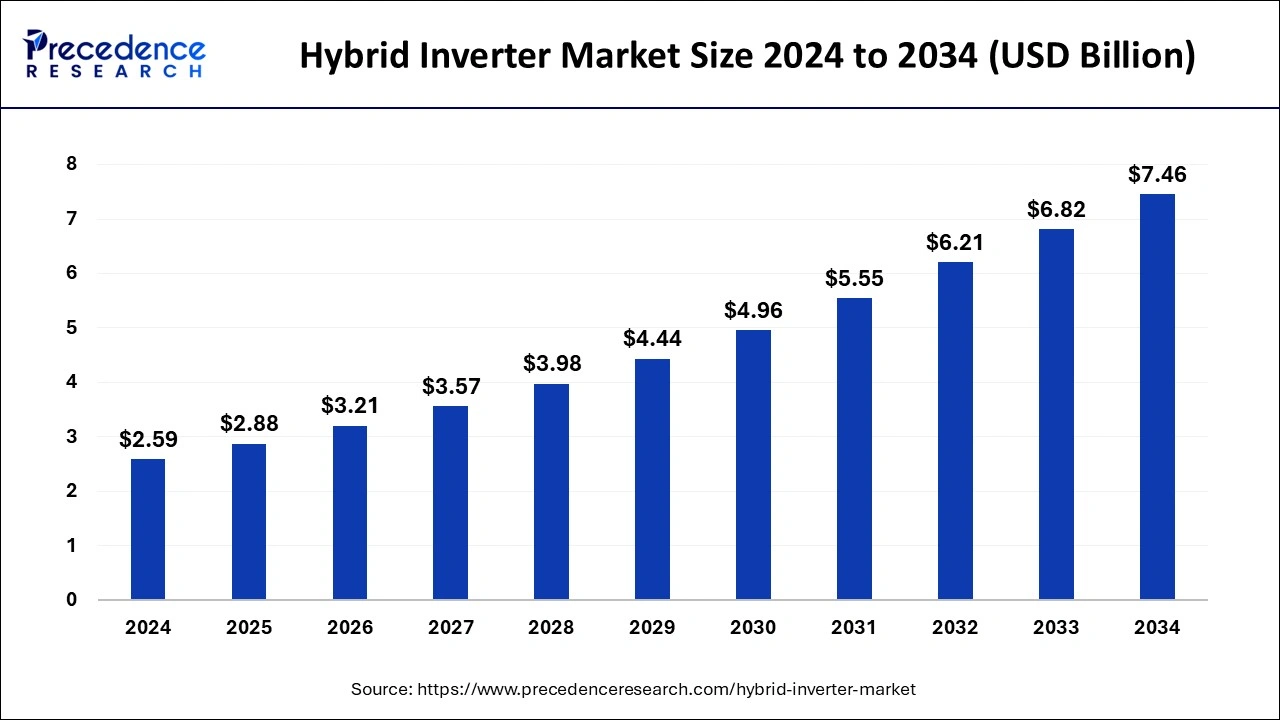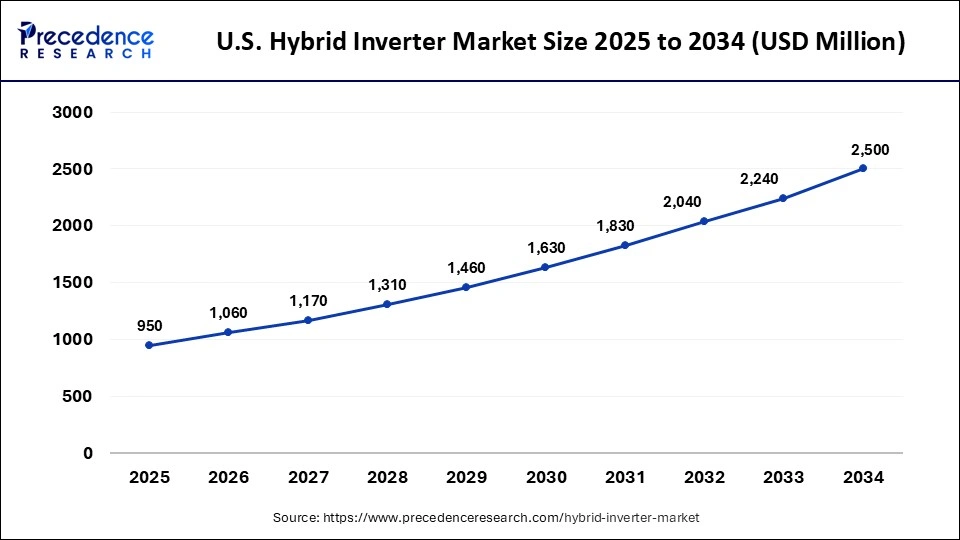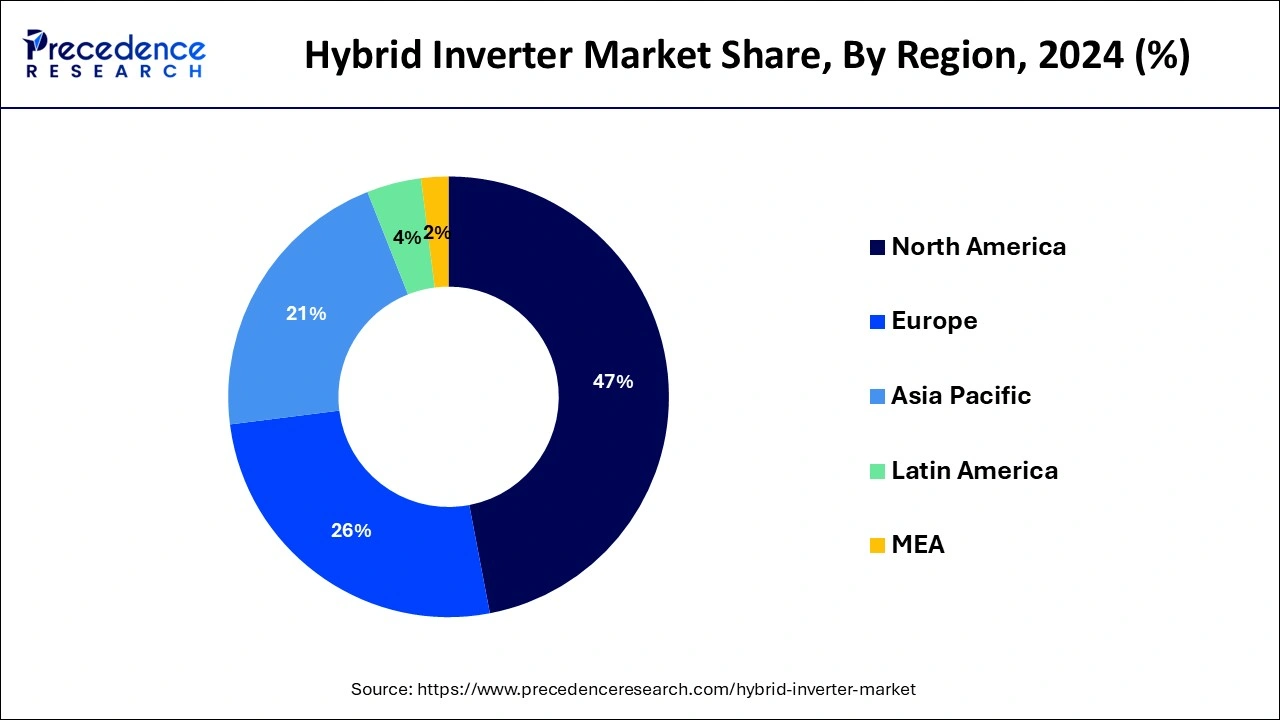November 2024
The global hybrid inverter market size is accounted at USD 2.88 billion in 2025 and is forecasted to hit around USD 7.46 billion by 2034, representing a CAGR of 11.16% from 2025 to 2034. The North America market size was estimated at USD 1.22 billion in 2024 and is expanding at a CAGR of 11.27% during the forecast period. The market sizing and forecasts are revenue-based (USD Million/Billion), with 2024 as the base year.
The global hybrid inverter market size was calculated at USD 2.59 billion in 2024 and is predicted to increase from USD 2.88 billion in 2025 to approximately USD 7.46 billion by 2034, expanding at a CAGR of 11.16% from 2025 to 2034.

The U.S. hybrid inverter market size was exhibited at USD 850 million in 2024 and is projected to be worth around USD 2,500 million by 2034, growing at a CAGR of 11.39% from 2025 to 2034.

North America has held the largest revenue share of 47% in 2024. In North America, the hybrid inverter market is witnessing robust growth driven by the increasing adoption of renewable energy solutions. The region's focus on sustainable practices, coupled with government incentives, propels the demand for hybrid inverters. With a growing emphasis on energy resilience and reducing carbon footprints, consumers are investing in hybrid inverters that integrate seamlessly with solar and storage systems.
Asia-Pacific is estimated to observe the fastest expansion. Asia-Pacific is a hotspot for hybrid inverter market dynamics. Rapid urbanization, coupled with a rising awareness of clean energy, fuels the demand for hybrid inverters. Countries like China and India are embracing renewable energy solutions, creating a conducive environment for hybrid inverter adoption. Technological advancements, government initiatives, and the need for reliable power sources contribute to the flourishing market in this dynamic and innovation-driven region.
In Europe, the hybrid inverter market thrives on the continent's commitment to sustainable energy practices. The push towards renewable energy, coupled with stringent environmental regulations, propels the adoption of hybrid inverters. The region's advanced infrastructure and focus on clean energy solutions create a favorable landscape for hybrid inverter manufacturers, fostering innovation and widespread integration into residential and commercial setups.

The hybrid inverter market involves the manufacturing and supply of hybrid inverters. These devices play a crucial role in converting direct current (DC) power generated from sources like solar panels into alternating current (AC) power, suitable for various applications in residential, commercial, industrial, and utility settings. Hybrid inverters are distinguished by their integration of energy storage functions, allowing users to store surplus energy for future use or operate independently of the grid.
This market caters to the growing need for versatile and energy-efficient solutions, aligning with the global shift towards sustainable and decentralized power systems. The hybrid inverter market is witnessing significant growth due to the rising adoption of renewable energy sources and the increasing need for energy independence. Hybrid inverters play a crucial role in optimizing energy utilization, reducing grid dependency, and enhancing distributed energy systems' overall efficiency. As the world shifts towards cleaner and more sustainable energy practices, the demand for hybrid inverters is expected to continue its upward trajectory.
| Report Coverage | Details |
| Growth Rate from 2025 to 2034 | CAGR of 11.16% |
| Market Size in 2025 | USD 2.88 Billion |
| Market Size by 2034 | USD 7.46 Billion |
| Largest Market | North America |
| Base Year | 2024 |
| Forecast Period | 2025 to 2034 |
| Segments Covered | Type, Product, and End User |
| Regions Covered | North America, Europe, Asia-Pacific, Latin America, and Middle East & Africa |
Driver
Smart inverters and off-grid solutions
Smart inverters are at the forefront of driving demand in the hybrid inverter market. These devices, equipped with advanced monitoring and control capabilities, provide consumers with a more intelligent and responsive energy management system. The integration of smart technologies allows users to monitor energy consumption, optimize power usage, and even participate in demand response programs. As smart home ecosystems expand, the demand for intelligent hybrid inverters seamlessly integrating with these systems is expected to surge.
The increasing demand for off-grid solutions is another significant driver of the hybrid inverter market. Off-grid systems, particularly in remote or rural areas, rely on hybrid inverters to manage power generated from renewable sources and stored in batteries. These solutions offer a reliable and sustainable energy source in locations where traditional grid access is challenging.
Additionally, off-grid hybrid inverters contribute to addressing energy access issues in regions without a centralized power infrastructure. The market experiences heightened demand as consumers seek alternative and independent energy solutions, fostering the growth of hybrid inverters for off-grid applications. As the need for decentralized power systems rises, the hybrid inverter market is projected to benefit from the surge in off-grid solution adoption.
Dependency on renewable energy sources, technology maturity and standardization
One major restraint in the hybrid inverter market is the dependence on renewable energy sources. It still faces challenges such as intermittent and unpredictability. Solar and wind power, the primary sources for hybrid inverters, are subject to variations in weather conditions. This dependency can result in fluctuations in energy production, impacting the reliability of the power supply. As a result, the effectiveness of hybrid inverters, which rely on consistent renewable energy input, is hindered by the inherent variability in these sources.
The hybrid inverter market is also restrained by technology maturity and standardization challenges. As the industry evolves, ensuring compatibility and interoperability among various hybrid inverter models becomes crucial. A lack of standardized communication protocols and features across different brands and models can create compatibility issues in integrated energy systems. Additionally, the maturity of technology may limit further breakthroughs, affecting the development of more efficient and advanced hybrid inverters. Standardization efforts are essential for establishing a cohesive market and overcoming interoperability challenges, enabling seamless integration into diverse energy systems.
Decentralized energy systems and increased energy efficiency
The surge in demand for hybrid inverters is significantly driven by the paradigm shift towards decentralized energy systems and the heightened emphasis on increased energy efficiency. Decentralized energy systems, characterized by the generation of power closer to the point of consumption, have gained traction due to their ability to enhance energy resilience and reduce reliance on traditional centralized grids.
Hybrid inverters play a pivotal role in this shift by efficiently integrating renewable energy sources like solar power into localized energy networks. Consumers increasingly seek energy independence, and hybrid inverters empower them to harness clean energy from sources like solar panels, fostering decentralized, self-sustained power generation.
Moreover, the market demand is fueled by the imperative for increased energy efficiency. As environmental concerns and sustainability goals take center stage, consumers and businesses alike are prioritizing solutions that optimize energy consumption. Hybrid inverters contribute to this objective by intelligently managing and distributing energy, ensuring that power is used more efficiently.
The ability of hybrid inverters to seamlessly integrate with energy storage solutions further enhances their efficiency, allowing for effective energy storage and utilization. As energy efficiency becomes a cornerstone of global energy initiatives, the demand for hybrid inverters continues to grow, promoting a more sustainable and resilient energy landscape.
According to the type, the on-grid hybrid inverters segment has held 59% revenue share in 2024. On-grid hybrid inverters are designed for solar power systems connected to the grid. They enable the seamless integration of solar-generated electricity with the grid supply, allowing excess energy to be fed back into the grid. The latest trends in on-grid hybrid inverters include enhanced grid stability features, smart grid compatibility, and improved efficiency in power conversion. These inverters are becoming increasingly popular as they facilitate efficient utilization of solar energy while ensuring a reliable power supply from the grid.
The grid-tied hybrid inverters segment is anticipated to expand at a significant CAGR of 12.8% during the projected period. Grid-tied hybrid inverters are similar to on-grid inverters but are equipped with additional features for backup power during grid outages. These inverters allow users to store excess solar energy in batteries, providing a continuous power supply even when the grid is down. Trends in grid-tied hybrid inverters focus on optimizing battery storage capacity, incorporating advanced energy management systems, and enhancing compatibility with emerging energy storage technologies. This ensures a more resilient and self-sufficient power supply for users, combining the benefits of grid connectivity and off-grid independence.
Based on the product, the single-phase hybrid inverters segment held the largest market share of 61.30% in 2024. Single-phase hybrid inverters are designed for residential and small-scale applications. They efficiently convert direct current (DC) from solar panels into alternating current (AC) for household use. Trends in this segment include enhanced energy storage integration, compact designs for easy installation, and smart functionalities for remote monitoring and control. With a focus on user-friendly features and seamless integration into residential setups, single-phase hybrid inverters cater to the growing demand for sustainable energy solutions in homes.
On the other hand, the three-phase hybrid inverters segment is projected to grow at the fastest rate over the projected period. Three-phase hybrid inverters are engineered for larger-scale applications, such as commercial and industrial settings. These inverters manage higher voltage and power capacities, making them suitable for larger solar installations. Trends in this category involve advanced grid-tie capabilities, improved energy management algorithms, and compatibility with energy storage systems. As businesses seek comprehensive energy solutions, three-phase hybrid inverters play a pivotal role in optimizing power generation, consumption, and grid interactions for enhanced operational efficiency.
In 2024, the commercial segment had the highest market share of 52% based on the end user. Commercial applications of hybrid inverters are prevalent in businesses and institutions. These systems cater to the diverse energy needs of commercial spaces, seamlessly integrating solar power with grid electricity. Trend-wise, there is a growing inclination towards hybrid inverters that offer enhanced energy management features, enabling businesses to optimize energy consumption and reduce costs.
The industrial segment is anticipated to expand at the fastest rate over the projected period. In industrial settings, hybrid inverters play a crucial role in ensuring a stable and reliable power supply. Industries often have high energy demands, and hybrid inverters help in efficiently managing energy from renewable sources and the grid. The trend in the industrial sector involves adopting advanced hybrid inverter technologies that provide not only reliable power backup but also contribute to sustainability goals by maximizing the use of renewable energy sources.
By Type
By Product
By End User
By Geography
For inquiries regarding discounts, bulk purchases, or customization requests, please contact us at sales@precedenceresearch.com
No cookie-cutter, only authentic analysis – take the 1st step to become a Precedence Research client
November 2024
September 2024
January 2025
January 2025